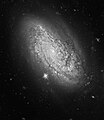Fișier:NGC 3021 Hubble.jpg

Mărimea acestei previzualizări: 520 × 599 pixeli. Alte rezoluții: 208 × 240 pixeli | 416 × 480 pixeli | 666 × 768 pixeli | 888 × 1.024 pixeli | 1.838 × 2.119 pixeli.
Mărește rezoluția imaginii (1.838 × 2.119 pixeli, mărime fișier: 1,75 MB, tip MIME: image/jpeg)
Istoricul fișierului
Apăsați pe Data și ora pentru a vedea versiunea trimisă atunci.
| Data și ora | Miniatură | Dimensiuni | Utilizator | Comentariu | |
|---|---|---|---|---|---|
| actuală | 1 iunie 2009 01:42 |  | 1.838x2.119 (1,75 MB) | Friendlystar | {{Information |Description={{en|1=Less than 100 years ago scientists didn't know if the universe was coming or going, literally. It even fooled the great mind of Albert Einstein. He assumed the universe must be static. But to keep the universe from collap |
Utilizarea fișierului
Următoarele pagini conțin această imagine:
Utilizarea globală a fișierului
Următoarele alte proiecte wiki folosesc acest fișier:
- Utilizare la ar.wikipedia.org
- Utilizare la arz.wikipedia.org
- Utilizare la az.wikipedia.org
- Utilizare la be.wikipedia.org
- Utilizare la ce.wikipedia.org
- Utilizare la diq.wikipedia.org
- Utilizare la eo.wikipedia.org
- Utilizare la eu.wikipedia.org
- Utilizare la fa.wikipedia.org
- Utilizare la hr.wikipedia.org
- Utilizare la kk.wikipedia.org
- Utilizare la lb.wikipedia.org
- Utilizare la mk.wikipedia.org
- Utilizare la my.wikipedia.org
- Utilizare la nl.wikipedia.org
- Utilizare la pt.wikipedia.org
- Utilizare la ru.wikipedia.org
- Utilizare la sh.wikipedia.org
- Utilizare la sk.wikipedia.org
- Utilizare la sr.wikipedia.org
- Utilizare la tr.wikipedia.org
- Utilizare la tt.wikipedia.org
- Utilizare la uk.wikipedia.org
- Utilizare la uz.wikipedia.org
- Utilizare la www.wikidata.org

